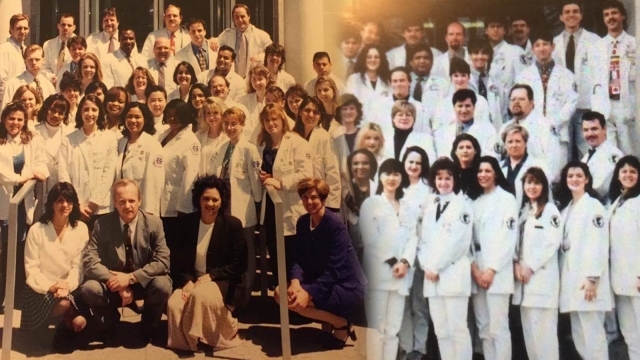
L to R: Catholic Medical Center, Class of 1996, and Bayley Seton, Class of 1996
As St. John’s University continues to celebrate its 150th anniversary, the Physician Assistant (P.A.) program in the University’s College of Pharmacy and Health Sciences is celebrating 25 years of accreditation.
“We extend heartfelt gratitude to the many educators and staff for their contributions over the years,” said Russell J. DiGate, Ph.D., Dean and Professor, College of Pharmacy and Health Sciences.
St. John’s has a long history of educating physician assistants. The first P.A. in New York State was issued a license in 1971; shortly afterward, St. John’s began enrolling undergraduate students in a pre-P.A. track. After three years of undergraduate course work, students who qualified either applied to Bayley Seton Hospital, formerly known as the United States Public Health Service Hospital, or Bronx Lebanon Hospital Center, for the P.A. program professional phase.
Following successful completion of the professional phase, students were awarded a Bachelor of Science degree in Physician Assistant Studies by St. John’s University and a P.A. certificate from their program, which made them eligible to sit for the NCCPA examination. A small number of independent students who previously earned bachelor’s or master’s degrees were also eligible to be admitted to the two-year P.A. certificate program.
As part of their clinical training, P.A. students from both programs rotated through a hospital system in Brooklyn and Queens, NY, in the Catholic Medical Center (CMC). This health system had multiple hospitals and nursing homes, as well as robust ambulatory clinics; physician assistants were employed in every department and clinical setting. It had a P.A. department with an administrative structure that represented every P.A. in every clinical discipline and practice setting throughout the health system.
The physician assistants reported administratively to the P.A. department leadership and clinically to the chair of the department in which they were credentialed. This was in the 1990s; it was a very progressive business model that created many successful physician assistants and P.A. leaders. The Director of the CMC’s P.A. department was Niels N. Schmidt, PA-C, M.B.A., and the department had two Associate Directors: Maureen C. Regan, PA-C, M.B.A., and Frank Acevedo, PA-C.
Among other accomplishments, these three leaders wrote the request for proposal to New York State for a P.A. program sponsored by the Catholic Medical Center. Mr. Acevedo became the inaugural Program Director of CMC’s P.A. program. Classes were held in a now-shuttered building, St. Anthony’s Hospital, in Woodhaven, Queens.
Ultimately, Bronx Lebanon decided to close their P.A. program; Bayley Seton Hospital, along with its physician assistant program, also closed. All qualified St. John’s undergraduate pre-P.A. students now attended Catholic Medical Center; independent students were also eligible to apply.
By this time, the P.A. program had moved to its current location at the Dr. Andrew J. Bartilucci Center, formerly known as St. Anthony’s. Eventually, the Accreditation Review Commission of P.A. Programs issued a standard of accreditation that hospital systems could no longer sponsor P.A. programs; P.A. programs had to be sponsored by a University.
St. John’s University took over the sponsorship of the CMC’s P.A. program on March 1, 2007, and issued graduates both their bachelor’s degree and P.A. certificate. Mr. Schmidt transitioned with the P.A. program and served as the program’s director until he retired.
In 2019, St. John’s University’s Physician Assistant program enrolled its first Master of Science Physician Assistant cohort, which marked the end of their bachelor P.A. program. The last bachelor’s cohort is set to graduate in May. St. John’s P.A. program has graduated exceptional physician assistants who went on to be leaders in P.A. education, health-care administration, and state and national P.A. advocacy.
Related News
Celebrating Care and Kindness: DAISY Awards Honor St. John’s Nursing Excellence
Three members of St. John’s University’s Department of Nursing community in the College of Pharmacy and Health Sciences were honored in 2025 with DAISY Awards, a recognition program established by The DAISY Foundation that celebrates, recognizes, and thanks nurses for the care and kindness they provide.
St. John’s Doctoral Candidate Honored at National Pulmonary Conference
A doctoral student from St. John’s University’s College of Pharmacy and Health Sciences recently earned national recognition for her research into pulmonary drug delivery.
Commencement Celebrates Gratitude, New Beginnings, and Lasting Connections
On a picture-perfect Sunday with a clear, blue sky and radiant sunshine, St. John’s University held its 155th annual Undergraduate-Level Commencement Exercise on May 18 on the Great Lawn of the Queens, NY, campus.
